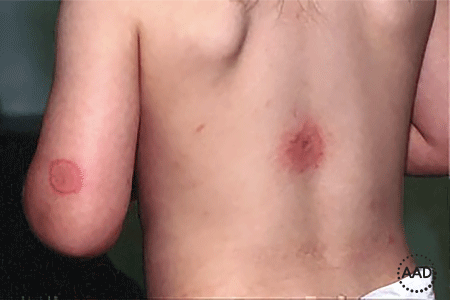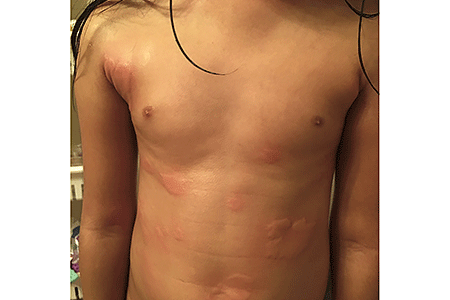Hives: Causes
What causes hives?
The often-itchy bumps and raised patches of hives develop when the body releases histamine.
Your body stores histamine inside cells. When your immune system recognizes a threat, it releases histamine and other chemicals. This cascade of chemicals can protect you from becoming seriously ill from an infection, spoiled fish, or a bug bite.
Sometimes, the immune system releases histamine when there is no real threat. This happens when people develop an allergic reaction. In fact, some people develop hives when they have an allergic reaction.
Some people develop hives when they have an allergic reaction
The hives on this boy’s skin are due to an allergic reaction to mosquito bites.

When the body mistakenly releases histamine and hives develop, the cause is often one of the following:
An allergic reaction
Overreaction to heat, sweat, or cold
Stress
Sunlight
Pressure on the skin (tight clothing, light touch of a purse strap, or scratching)
When hives are due to an allergic reaction, it’s often an allergy to:
A food
Bug bite or sting
Latex
Medication
Pet dander
Plant
Pollen
Infection or medical treatment can trigger hives
Some people get hives when they develop an infection like strep throat, a urinary tract infection, or COVID-19.
Others get hives when they have a medical treatment like radiation therapy or a blood transfusion.
Hives was the first sign of COVID-19 for this girl
A few days after getting hives, this 5-year-old girl began to develop the more common symptoms of COVID-19 like fever and a cough.

Hives due to radiation therapy
This medical treatment can be lifesaving but hard on your skin. If your body releases histamine to protect itself, hives can develop.

What triggers hives often remains a mystery
While some people can trace hives back to a trigger like an allergic reaction, exposure to cold, or stress, the cause remains a mystery for many people.
It’s estimated that millions of people in the United States will develop hives during their lifetime and never find the cause. Some of these people will continue to have hives for six weeks or longer. When this happens, the person has a medical condition called chronic spontaneous urticaria.
Urticaria (ur-tih-KAR-e-uh) is the medical word for hives.
When chronic, hives can continue to appear for months and sometimes years. During this time, the swelling, pain, and discomfort can be difficult to live with.
Women are twice as likely as men to develop chronic spontaneous hives during their lifetime. Most women develop this condition when they are 20 to 40 years of age.
Some people have a greater risk of developing any type of hives
While anyone can develop hives, you have a greater risk if you:
Are a woman of African American heritage (4 to 5 times greater risk than white people)
Have atopic dermatitis (eczema)
Smoke cigarettes
If you have long-lasting or widespread hives, seeing a dermatologist can help you feel more comfortable. Seeing a dermatologist is also a good idea to make sure that what you have really is hives.
Find out how dermatologists diagnose and treat hives at: Hives: Diagnosis and treatment.
Images
Image 1: Used with permission of the American Academy of Dermatology National Library of Dermatologic Teaching Slides.
Image 2: Images used with permission of JAAD Case Reports.
JAAD Case Reports 2021;11:137-8.
Image 3. Image used with permission of the Journal of the American Academy of Dermatology.
J Am Acad Dermatol 2006;54(1)28-46.
References
Antia C, Baquerizo K, et al. “Urticaria: A comprehensive review: Epidemiology, diagnosis, and work-up.” J Am Acad Dermatol. 2018;79(4):599-614.
Grattan CEH, Saini SS. “Urticaria and angioedema.” In: Bolognia JL, et al. Dermatology. (4th edition). Mosby Elsevier, China, 2018:304-19.
Hide M, Takahagi S, et al. “Urticaria and angioedema.” In: Kang S, et al. Fitzpatrick’s Dermatology. (9th edition) McGraw Hill Education, United States of America, 2019:684-785.
Hymes SR, Strom EA, et al. “Radiation dermatitis: Clinical presentation, pathophysiology, and treatment.” 2006. J Am Acad Dermatol. 2006;54(1):28-46.
Le NK, Brooks JP. “Acute urticaria as the initial presentation of COVID-19 in a pediatric patient.” JAAD Case Rep. 2021;11:137-8.
Rosman Y, Hershko AY, et al. “Characterization of chronic urticaria and associated conditions in a large population of adolescents.” J Am Acad Dermatol. 2019;81(1):129-135.
Written by:
Paula Ludmann, MS
Reviewed by:
DiAnne Davis, MD, FAAD
Elisa Gallo, MD, FAAD
William Warren Kwan, MD, FAAD
Shari Lipner, MD, PhD, FAAD
Last reviewed: 5/30/24
 Atopic dermatitis: More FDA-approved treatments
Atopic dermatitis: More FDA-approved treatments
 Biosimilars: 14 FAQs
Biosimilars: 14 FAQs
 How to trim your nails
How to trim your nails
 Relieve uncontrollably itchy skin
Relieve uncontrollably itchy skin
 Fade dark spots
Fade dark spots
 Untreatable razor bumps or acne?
Untreatable razor bumps or acne?
 Tattoo removal
Tattoo removal
 Scar treatment
Scar treatment
 Free materials to help raise skin cancer awareness
Free materials to help raise skin cancer awareness
 Dermatologist-approved lesson plans, activities you can use
Dermatologist-approved lesson plans, activities you can use
 Find a Dermatologist
Find a Dermatologist
 What is a dermatologist?
What is a dermatologist?